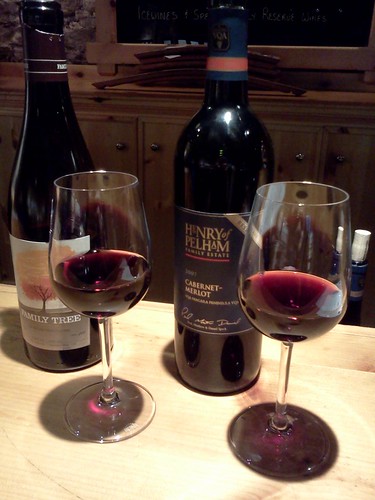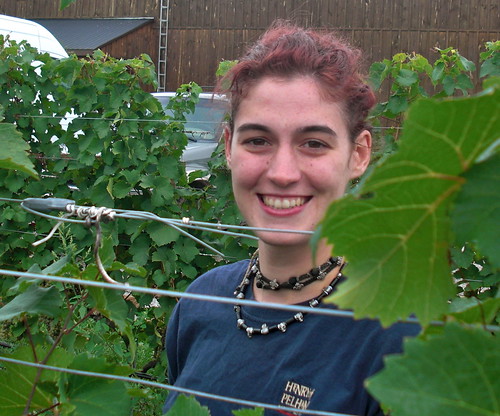
Note: We are following the 2011 grape harvest in Niagara through the writings of several Niagara insiders. This is the sixth post from Melissa Smits, a cellar/winery technician at Henry of Pelham Family Estate Winery. This is Part XV of our #Harvest2011 reports.
By Melissa Smits

Harvest continued this week with the last Syrah for Family Tree Red (a new blend introduced last year — the first vintage was 2009 and seen in the top photo beside the Cab-Merlot) and the majority of the tonnage of Cabernet Franc, Merlot and Cabernet Sauvignon.
As we’ve been monitoring our blocks of the later-season varieties, we haven’t seen too much of a visual change for better or for worse. I mentioned before that we’re experiencing a low-acid year because of the rainfall. Considering the pH of the juices, the two prominent types of acid (tartaric and malic) also have a ratio to themselves.
Tartaric gives structure to the palate and balances tannin, alcohol, and any residual sweetness. Malic acid lends a green-apple sharpness to fruit. When we harvest Pinot Noir for sparkling wines, there is more malic present in the fruit as it’s less ripe than the Pinot we bring in for table reds.
As ripening continues, both malic and tartaric acids drop and the pH will rise, at the same time sugars should be increasing in the fruit. Then, when the temperature drops in the autumn, the grapevine responds by changing its physiological processes to prepare for the cold winter. Leaves drop, water movement changes and certain tissues begin lignification; the vine is entering dormancy. If bunches still hang, and the acid content is still high at this point, it stands very little chance of dropping any further.
This year, the cold is a little more welcome because acids are already low. If they continue to drop, the wines will be flabby, out of balance and generally poorly structured. So a cool fall keeps acids a little more fixed; more in balance with sugars.
The Cabernet varieties and Syrah have tougher skin than Pinot Noir and Chardonnay, so they are not as easily damaged. They can still be affected by botrytis and rot, however, so we’ve been watching them closely.
The looser cluster structure helps as well: berries don’t split as readily if they experience a rapid change of size (say, with water intake). The sunny days that we have had have allowed a good accumulation of sugars for reaching our target alcohol percentages.
When I sample bins for testing, my nose and eyes become highly critical. Visually, I’m looking for ladybeetles or other pests, and if anything smells weird/unhealthy it’s unlikely to make very good wine.
I’ve seen some pretty consistent health in these varieties, and they smell clean. The Cabernet Sauvignon juices have tasted really good, too! Usually ladybeetles are looking for a place to hibernate in the autumn (such as a cozy cluster of grapes), but I haven’t seen very many.
We’re wrapping up the harvest now, and I’ve been thinking about the range of wines that Niagara produces. Lately a topic of discussion in the wine community has been centred around inexpensive blends emerging from all sizes and styles of Niagara wineries.
We all have different goals specific to the different businesses, but overall there’s a lot of motivation to just attracting attention to local wines. Each winery is its own world just as much as it fits into a bigger picture, and each has their own way of provoking curiosity.
Having a wide range of styles does invite people with all preferences and wine knowledge to explore such a world. As familiarity with Niagara wines increases, it allows people to discover more of the single varietal and single vineyard wines produced at these wineries, as time passes. This may not be something that happens at a rapid rate, but put into perspective with the wine industries of the world, we’re still young.
We have a lot of variables at play here, and complexity makes our industry interesting. Our Cabernet Sauvignon and Syrah are destined to go into a few different blends, each with their own spot on the shelf. Where they go from there depends on preferences and perceptions, and to each their own.
Cheers!
Melissa Smits







Comment here